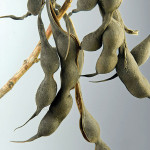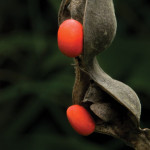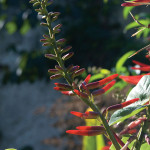The Sacred Red Bean
But not from a vine, from a tree — the Palo de Pito
The palo de pito tree is commonly found throughout the Highlands of Guatemala. It produces a bright red bean, which is used for divination by Maya shamans. The book of Popol Vuh is very clear about the red beans from this tree being used by the gods when they created the world for humans and animals.
The tree is easy to propagate; all you need to do is put one of its strong twigs in the ground and it will soon grow roots at its base and leaves on top. Within a year, you will have a nice tree with attractive red flowers.
The flowers are pretty and edible, but don’t eat the beans—they are toxic! You can also use the green buds of the leaves as a tea to induce sleep, but don’t experiment by yourself. Find a local person with experience to provide recipes and explain which parts to eat.
Legend says the wood from this tree was used to create a species of pseudo-humans during one of the early Maya creations. Today it is used to carve statues of Maximón (see Revue feature, June 2011).
Many tourist shops throughout Guatemala offer necklaces and other jewelry made from these red beans. Cuidado, be careful! Remember, they are poisonous. U.S. Customs will confiscate any jewelry made from them.
Further reading
Refer to the World Agroforestry Centre, where you can find many articles on various species of palo de pito and related trees. While university and government websites provide technical information, other sites tend to make non-proven claims, for instance, on subjects including the hallucinogenic and aphrodisiac properties of the palo de pito.
Scientific name: Raphael Girard is one of the early users of Erythrina corallodendron as the scientific name for palo de pito. All subsequent translators of the Popol Vuh have used Erythrina corallodendron, seemingly not checking with botanists. Today botanists use the name Erythrina berteroana for the species in Guatemala. Erythrina poeppigiana is primarily in South America. Erythrina herteroana is one species mentioned in Chiapas, Mexico.
One goal of the FLAAR research on plants and animals of the Mayan world is to suggest which topics are good for thesis or dissertation research. The palo de pito is definitely an interesting tree. I hope this article and our website, www.maya-archaeology.org are an inspiration to students for thesis topics.
You can contact Dr. Hellmuth at frontdesk@flaar.org or FLAAR (Foundation for Latin American Anthropological Research) at reader-service@flaar.org



Hello! My name is J. Contreras, I am a professor at Esatern New Mexico University. Every July I take a bout 15 students to Guatemala, where they study about the Mayas and the country in general. Please send me more info about El Pilar, so I can visit you in July. Thank you! vit